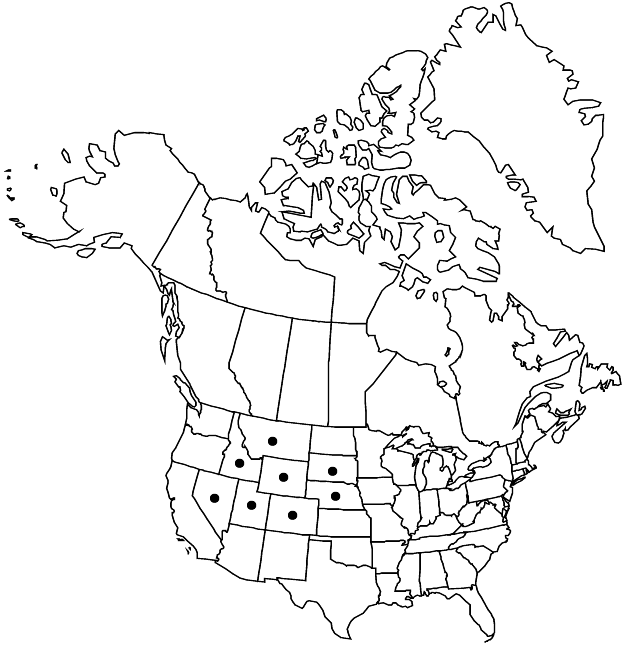Eriogonum brevicaule
Proc. Acad. Nat. Sci. Philadelphia 4: 15. 1848.
Herbs, matted, cespitose, pulvinate, erect or spreading, sometimes scapose, (0.3–)1–5 × 1–5(–8) dm, tomentose to floccose or glabrous, grayish or greenish to green. Stems matted to spreading, occasionally with persistent leaf bases, up to 1/4 or more height of plant; caudex stems matted or spreading; aerial flowering stems spreading to erect or nearly so, slender, rarely stout, solid, not fistulose, (0.4–)0.5–2(–2.5) dm, glabrous, floccose, or sparsely to densely tomentose to lanate. Leaves basal or more commonly sheathing 1–7(–15) cm up stem, 1 per node; petiole 0.2–2(–4) cm, tomentose to floccose; blade linear, oblanceolate, or spatulate to elliptic, (0.2–)1–10(–12) × 0.1–0.9(–1.2) cm, densely tomentose abaxially, less so to floccoseadaxially, margins plane or revolute, sometimes crenulate. Inflorescences cymose, subumbellate, umbellate, or capitate, (1–)3–10(–25) × (0.7–)1–10(–15) cm; branches dichotomous, sometimes absent, tomentose to floccose or glabrous; bracts 3, triangular, scalelike, 1–3(–5) mm. Peduncles absent or erect, 0.3–3 cm, tomentose to floccose or glabrous. Involucres 1 per node or 3–7(–9) per cluster, turbinate to turbinate-campanulate, 1.5–4(–5) × (1–)1.5–3(–3.5) mm, tomentose to floccose or glabrous; teeth 5, erect to spreading, 0.3–1 mm. Flowers (1–)2–4 mm; perianth various shades of white to cream or yellow, glabrous or pubescent; tepals connate proximal 1/4–1/3, monomorphic, lanceolate, oblong to obovate or ovate to oval; stamens exserted, 2–4 mm; filaments pilose basally. Achenes light brown to brown, 2–3 mm, glabrous except for roughened to papillate beak.
Distribution

w United States.
Discussion
Varieties 8 (8 in the flora).
Eriogonum brevicaule is highly variable, and the variation has yet to be fully resolved taxonomically. The expressions recognized here will encompass the vast majority of populations. The extreme variation previously under the name var. laxifolium is now reduced with the recognition of var. bannockense (low-elevation or northern phase), var. nanum, and var. caelitum (high-elevation, southern phases).
Essentially all of the following species (28–63 below) belong to the Eriogonum brevicaule complex. Eriogonum desertorum, E. loganum, E. spathulatum, E. ostlundii, and E. artificis are allied to the complex associated with var. laxifolium, while E. natum is related to var. cottamii. Eriogonum viridulum and E. ephedroides are allied to E. brevicaule var. brevicaule as are E. contortum and E. acaule. Eriogonum brandegeei is also related, but exactly how is less certain. Allied to this complex of species are on the one hand those related to E. batemanii, and on the other all of the matted perennials belonging to the E. ochrocephalum complex. Essentially all of these species form relatively small populations on discrete edaphic sites and are well isolated one from the other. Unfortunately, a clear separation of E. brevicaule from E. desertorum, E. loganum, and E. spathulatum is not always possible.
Selected References
None.
Lower Taxa
Key
| 1 | Flowering stems and inflorescence branches glabrous | > 2 |
| 1 | Flowering stems and inflorescence branches floccose to tomentose or lanate | > 3 |
| 2 | Plants not pulvinate or cespitose, (0.8-)1.5-5 dm; inflorescences cymose, open, divided 3 times or more; widespread | Eriogonum brevicaule var. brevicaule |
| 2 | Plants pulvinate and cespitose, 0.3-1.5(-1.8) dm; inflorescences capitate or umbellate to cymose and divided 1-2 times; Utah | Eriogonum brevicaule var. nanum |
| 3 | Perianths pubescent; se Montana, ne Wyoming | Eriogonum brevicaule var. canum |
| 3 | Perianths glabrous; sc Idaho, ne Nevada, Utah, sw Wyoming, not se Montana or ne Wyoming | > 4 |
| 4 | Inflorescences divided (2-)3-5 times; perianths usually yellow, rarely ochroleucous | > 5 |
| 4 | Inflorescences capitate or umbellate to cymose and divided 1-2 times; perianths ochroleucous or yellow | > 6 |
| 5 | Flowers (1-)1.5-2.5 mm; sw Wyoming | Eriogonum brevicaule var. micranthum |
| 5 | Flowers (2.5-)3-4 mm; Utah | Eriogonum brevicaule var. cottamii |
| 6 | Leaf blades linear to narrowly oblanceolate; inflorescences capitate or divided | > 7 |
| 6 | Leaf blades linear, oblanceolate, or narrowly oblanceolate to elliptic; inflorescences capitate. [8. Shifted to left margin.—Ed.] | > 8 |
| 7 | Leaf blades (1.5-)3-9(-12) × 0.1-0.5(-0.7) cm, tomentose abaxially, less so and grayish or occasionally greenish adaxially, margins usually revolute, occasionally plane; perianths ochroleucous or yellow; n Utah, se Idaho, below 2800 m | Eriogonum brevicaule var. laxifolium |
| 7 | Leaf blades 0.2-4.5(-5) × (0.2-)0.3-0.6(-0.7) cm, tomentose abaxially, thinly floccose and bright green adaxially, margins plane or slightly thickened; perianths yellow; c Utah, above 2700 m | Eriogonum brevicaule var. caelitum |
| 8 | Leaf blades and flowering stems bright green under the thinly floccose pubescence; ne Nevada and nw Utah | Eriogonum brevicaule var. laxifolium |
| 8 | Leaf blades and flowering stems usually grayish to dull greenish under tomentum, rarely thinly floccose; se Idaho and sw Wyoming s to n Utah and ne Nevada | > 9 |
| 9 | Leaf margins crenulate; leaf blades narrowly oblanceolate to narrowly elliptic, (0.3-)0.5-1.5(-2) × 0.2-0.5(-7) cm, densely white-tomentose abaxially, floccose and greenish adaxially | Eriogonum brevicaule var. nanum |
| 9 | Leaf margins usually plane (rarely crenulate in Wyoming); leaf blades narrowly oblanceolate to oblanceolate, (0.8-)1-4(-4.5) × (0.3-)0.4-0.8 cm, densely tomentose abaxially, tomentose to floccose and grayish to greenish adaxially | Eriogonum brevicaule var. bannockense |